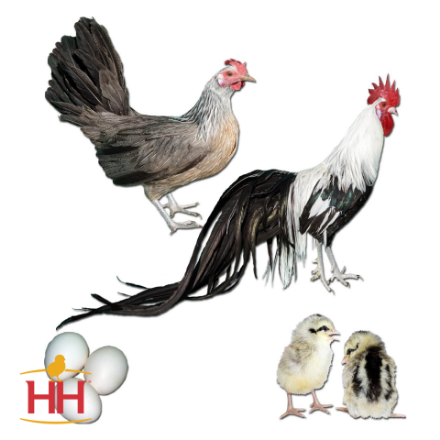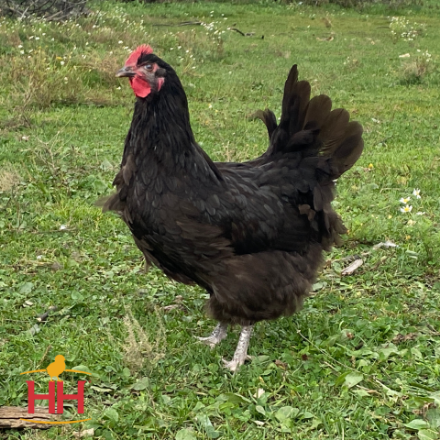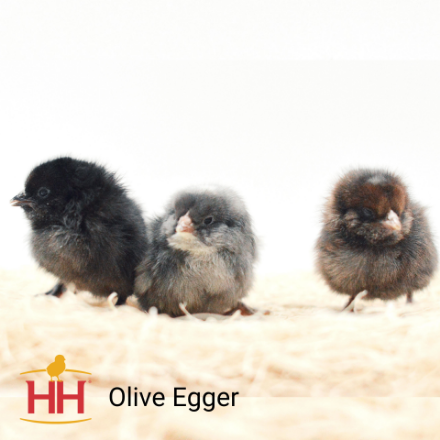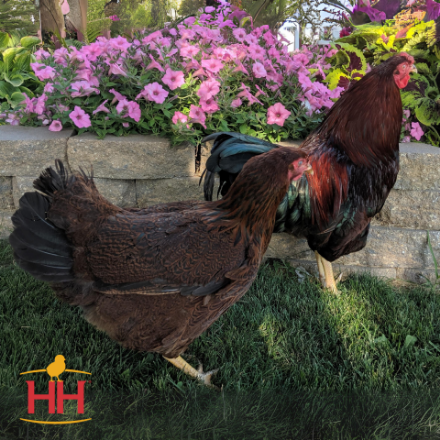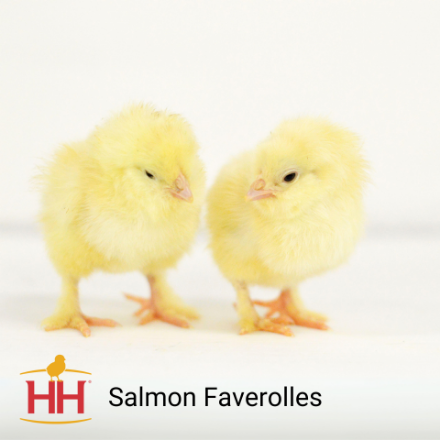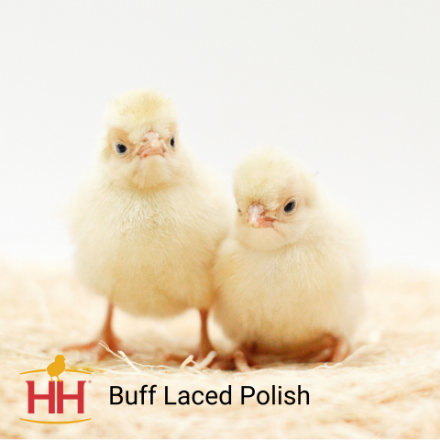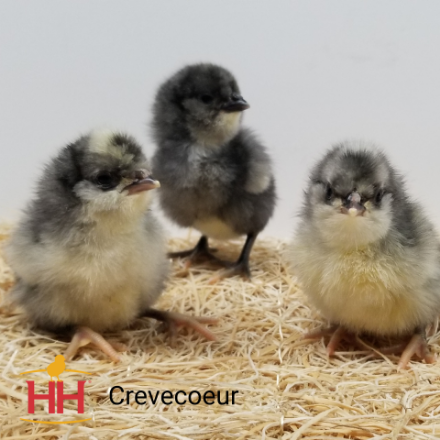Chicks
Our minimum shipping quantity for chicks is 15. There is a minimum of 5 per sex and breed. We reserve the right to change order minimums as needed.
This is the bird that single-handedly changed American eating habits. Before Cornish Cross Broilers were developed, a chicken dinner was a rare treat reserved for special occasions. Pre-Cornish Cross era chickens grew slowly while eating plenty of feed. Their meat was tasty but sparse. The Cornish Cross made broiler production efficient, and today it’s often the most inexpensive meat the grocery store sells. Cornish Cross Broilers require special feeding and care but grow astonishingly fast. They weigh nearly six pounds when only six weeks old by efficiently converting feed into flesh. Cornish Cross Broilers are the best choice for a person who wants to quickly produce delicious meat and has no plan to save hens for egg production. Purpose: Meat Bird Production: Matures Between 6-8 Weeks Temperament: Docile, Sedentary Mature Weight: 6-8 lbs. Hardiness: Cold and Heat Hardy
Currently Unavailable
The Phoenix chicken is a bird that was developed in Germany from Japanese long-tailed birds. Phoenix are tolerant of heat and are primarily used for exhibition and ornamental purposes. Under proper care and the right conditions, Phoenix males can display impressive long tails.
Currently Unavailable
The Russian Orloff is a unique bird with the rare walnut comb and is bearded. The Russian Orloff is spangled brown and white that can vary between shades of orange and black as well. They have an upright carriage with a slightly sloping back that gives them a distinctive appearance. They make a good dual-purpose chicken and are very winter hardy owing to their Russian origin.
Currently Unavailable
Sicilian Buttercups are active foragers and alert chickens that are good for warmer climates. They are good layers of white eggs. They sport a unique gold and black barred plumage in females which reflects as a red color in males.
Starting at: $4.81
The Silver Phoenix is a gorgeous ornamental and exhibition variety of bird. Like the Golden Phoenix, the Silver Phoenix was developed in Germany from Japanese long tailed birds. Males can grow an exceptionally long tail under the right conditions and with great individual care. Males have a silvery white head and back with a greenish black colored breast. Females are silvery gray with a salmon-colored breast. Available as straight run only.
Currently Unavailable
An exhibition favorite, the White Faced Black Spanish chicken has glassy black feathers and over-developed white, low hanging ear lobes. They have a single comb and four toes, and lay white eggs.
Currently Unavailable
The Ancona is an old Italian breed that is known for its ability to lay lots of white-shelled eggs. They are a lightweight breed that can have either a single or rose comb. The males develop long flowing tail feathers that make them especially eye-catching. The plumage is black with white-tipped feathers, this is known as mottling. With each molt, birds tend to get whiter. They are active birds, are great foragers, and thanks to their smaller size they eat less than larger breeds. Purpose: Egg Layer Production: 240 Medium White Eggs/Year Temperament: Social, Active, Vocal Mature Weight: 4-6 lbs. Hardiness: Cold and Heat Hardy Broodiness: Occasionally Comb Type: Single Comb
Starting at: $5.06
Barnevelders are medium heavy, dual-purpose birds that are very cold hardy. Their beautiful double-laced brown and blue feathers are just another perk of this docile bird that takes to foraging easily. The Barnevelders are single combed with yellow legs. Purpose: Dual-Purpose Production: 160 Large Dark Brown Eggs/Year Temperament: Docile, Curious, Active, Gentle Mature Weight: 5-7 lbs. Hardiness: Cold and Heat Hardy Broodiness: Occasionally Comb Type: Single Comb
Currently Unavailable
The original ancestors of the Andalusian came from Spain, but British poultry fanciers are believed to be the ones to perfect the breed. The Andalusian is most well-known for its striking blue plumage, with ground color being slate blue and each feather being laced with darker blue. Their large red combs, wattles, and white earlobes make a beautiful bird. They have an active disposition and are known to be excellent foragers. The males will develop a large, full tail at maturity along with long flowing saddle and hackle feathers. Like all Mediterranean breeds, they can handle hot temperatures well. This breed hatches black, blue, and splash coloring; there is no guarantee what color you will receive. Purpose: Egg Layer Production: 265 Medium White Eggs/Year Temperament: Active, Energetic, Vocal Mature Weight: 4-6 lbs. Hardiness: Cold and Heat Hardy Broodiness: Rarely Comb Type: Single Comb
Currently Unavailable
Blue Jersey Giants, like their Black counterparts, are one of the largest and most impressive breeds of chicken. Their large, imposing size combined with their beautiful blue feathers makes the Blue Jersey Giant truly a one-of-a-kind bird. They are slow maturing, taking about 6 months to reach their full size and are moderate layers of brown eggs. Purpose: Dual-Purpose Production: 240 X-Large Brown Eggs/Year Temperament: Docile, Easy Going Mature Weight: 8-9 lbs. Hardiness: Cold and Heat Hardy Broodiness: Occasionally Comb Type: Single Comb
Currently Unavailable
These lacy girls are not all show with their elegantly patterned feathers. They are also great egg layers! Wyandottes are one of the most strikingly beautiful chickens to grace a backyard flock. Developed in New York, they are quiet, easy to manage, and are one of the most winter-hardy breeds. Purpose: Dual-Purpose Production: 200 Medium Cream Eggs/Year Temperament: Docile, Friendly Mature Weight: 6-7 lbs. Hardiness: Cold and Heat Hardy Broodiness: Often Comb Type: Rose Comb
Starting at: $5.06
The Chantecler is a cold-hardy, dual purpose breed that was originally developed in Canada in the early 1900s. The first Chanteclers were created by crossing Wyandottes, Cochins, Cornish, and Leghorns. The goal was to create a hardy, dual purpose bird that could withstand the harsh Canadian winters, lay a good number of eggs, and produce a good carcass for the table. Chanteclers feature small cushion combs along with small, practically non-existent, wattles and dense feathering. All of these traits make it very well suited to cold northern climates. APPROX. 200 LARGE EGGS/YEAR | EGG COLOR: BROWN | MATURE WT: MALE 9 LBS. FEMALE 7 LBS.
Currently Unavailable
The large fowl Cochin is an ancient breed originally from China. When they first arrived in the U.S., they were immensely popular and were used to develop many American breeds such as the Plymouth Rock and Rhode Island Red. Although originally prized as a meat bird, Cochins today are primarily bred for exhibition. They have a docile temperament and are very cold hardy thanks to their abundant, loose-fitting plumage. The hens are also well known for their broody instincts and mothering ability.
Currently Unavailable
The Chocolate Orpington is a Hoover’s Hatchery™ specialty. It is a cross between a Chocolate Orpington male and a Black Orpington female. The pullets are a rich chocolate brown color. These birds make a great dual-purpose bird for any flock as they combine unique plumage color and high egg production with a well-fleshed carcass. This cross also has a docile temperament much like both of its parent breeds. Purpose: Dual-Purpose Production: 200 Medium Brown Eggs/Year Temperament: Docile, Friendly, Calm, Gentle Mature Weight: 8-9 lbs. Hardiness: Cold and Heat Hardy Broodiness: Often Comb Type: Single Comb
Currently Unavailable
Hampbars were originally developed in Canada in the 1950s to be an autosexing, dual-purpose breed. They were developed by crossing a Redbar into New Hampshires. Hampbars were beneficial over the other autosexing and dual-purpose breeds because of their light pin feathers which produced a cleaner carcass for the table. This is a very unique breed that is extremely rare. Purpose: Dual-Purpose Production: 240 X-Large Brown Eggs/Year Temperament: Calm, Friendly Mature Weight: 5-6 lbs. Hardiness: Cold and Heat Hardy Broodiness: Somewhat Comb Type: Single Comb
Currently Unavailable
The Midnight Majesty Marans® have black plumage and most hatch with feathered feet, but some do not. Deep browns show up through their down feathering underneath, making them a mix of beautiful dark brown and black plumage. The males are barred. This breed will lay dark brown eggs and will lay a lot of them! You will truly enjoy this breed in your backyard flock and its dark eggs in your egg carton! These hybrids perform well in many different climates. Purpose: Egg Layer Production: 250 Large Dark Brown Eggs/Year Temperament: Calm, Friendly Mature Weight: 7-8 lbs. Hardiness: Cold and Heat Hardy Broodiness: Occasionally Comb Type: Single Comb
Starting at: $5.06
Our Olive Eggers come from a couple of different crosses. We have one line that is a cross of Americanas and French Cuckoo Marans. With this hybrid, most of the females will be black but a few will come out blue. We also have another cross that is between Legbars and Welsummers, our goal with these is to create a green egg that is speckled similar to the Welsummers. Both crosses have a chance of laying brown eggs. Purpose: Dual-Purpose Production: 260 Large Olive Eggs/Year Temperament: Mellow, Active, Friendly, Docile Mature Weight: 5-6 lbs. Hardiness: Cold and Heat Hardy Broodiness: Rarely Comb Type: Pea Comb
Currently Unavailable
Partridge Chantecler males have brilliant rich red plumage on the neck and saddle with black tails and breasts while the females are a rich mahogany brown with each feather having intricate black markings known as “penciling”.The Chantecler is a cold-hardy, dual purpose breed that was originally developed in Canada in the early 1900s. The first Chanteclers were created by crossing Wyandottes, Cochins, Cornish, and Leghorns. The goal was to create a hardy, dual purpose bird that could withstand the harsh Canadian winters, lay a good number of eggs, and produce a good carcass for the table. Chanteclers feature small cushion combs along with small, practically non-existent, wattles and dense feathering. All of these traits make it very well suited to cold northern climates. APPROX. 200 LARGE EGGS/YEAR | EGG COLOR: BROWN | MATURE WT: MALE 9 LBS. FEMALE 7 LBS.
Currently Unavailable
Discover the enchanting Pearl Onyx Chicken, a striking breed that combines beauty and personality! With their shimmering pearl-like feathers interspersed with rich onyx hues, these birds are a visual delight, making them a standout addition to any flock. Known for their friendly and curious nature, Pearl Onyx Chickens are not only stunning but also great companions. They thrive in social environments and are excellent layers, producing medium-sized brown eggs that are perfect for any kitchen. Their calm demeanor makes them suitable for families, ensuring a delightful experience for both seasoned farmers and newcomers alike.
Starting at: $2.37
People own Salmon Faverolles for their silliness and their steady egg production. These bearded beauties are great docile birds that are very friendly. The breed originated in France and became the premier meat and egg laying breed at the Paris market in the late 1800s. The salmon color is the most prominent in Europe and where they are available in the U.S. Purpose: Ornamental Production: 180 Medium Light Brown Eggs/Year Temperament: Docile, Friendly, Calm, Quiet Mature Weight: 4-5 lbs. Hardiness: Cold Hardy But Not Heat Hardy Broodiness: Occasionally Comb Type: Single Comb
Currently Unavailable
Our Sapphire Splash® is a rebel rendition of our Sapphire Gem, with a mix of light to medium dark gray plumage and specks of darker feathering showing up throughout its body. This Czech breed has great performance just like its other Czech cousins. It is both cold and hot weather hardy and is a high performing egg producer. Please note that due to its splash coloring the colors of the bird will vary. Purpose: Egg Layer Production: 290 Large Brown Eggs/Year Temperament: Docile, Easy to Care For Mature Weight: 6-7 lbs. Hardiness: Cold and Heat Hardy Broodiness: Occasionally Comb Type: Single Comb
Starting at: $5.06
The Starlight Green Egger™ is very similar to the Prairie Bluebell Egger™. This breed was created by crossing the Prairie Bluebell Egger™ with a brown egg layer, the result is a chicken breed that lays high quantities of only green eggs. As with the Prairie Bluebell Egger™, the Starlight Green Egger™ is a lightweight and very active breed that is an excellent forager in free-range situations. The plumage color is also highly variable and comes in many beautiful color patterns not typically seen. If you are looking for a bird that consistently lays a green egg and will lay a lot of them, all while having a beautiful color pattern, then the Starlight Green Egger™ will be a great addition to your flock! *There may be a 5% chance of laying brown eggs with this hybrid. Purpose: Egg Layer Production: 280 Large Green Eggs/Year Temperament: Active, Easy Going Mature Weight: 5-6 lbs. Hardiness: Cold and Heat Hardy Broodiness: Rarely Comb Type: Pea Comb
Starting at: $5.06
The Turkens are not half chicken and half turkey, they are a unique chicken with a bare neck like the turkey and with very little feathering around the breast and wing areas. Despite their lack of feathers, they are very cold weather tolerant. They are friendly and easy to tame, plus they make for great conversation with curious neighbors. Purpose: Dual-Purpose Production: 265 Large Brown Eggs/Year Temperament: Docile, Friendly, Easily To Tame Mature Weight: 6-7 lbs. Hardiness: Heat and Cold Hardy Broodiness: Occasionally Comb Type: Single Comb
Starting at: $5.06
When created, the White Jersey Giant was the result of merging the genetics of several large breeds. This breed grows slowly but eventually are a third larger than most other heavy breeds. This breed has an impressive hen that lays about 240 extra-large eggs annually. When younger, the birds will mature relatively quick, but tend to reach marketable meat weight slower than other breeds. Purpose: Dual-Purpose Production: 240 X-Large Brown Eggs/Year Temperament: Docile, Easy Going Mature Weight: 8-9 lbs. Hardiness: Cold and Heat Hardy Broodiness: Occasionally Comb Type: Single Comb
Currently Unavailable
Mystic Onyx® were originally developed as a meat bird for a market similar to the Asian Blacks, but upon seeing their beauty, we decided to make these available to the public. These birds were developed from Silkies by crossing with meat birds and selecting for size, and their dark skin and meat. They resemble a Svart Hona or Ayam Cemani in color but typically feature orange-red flares in their plumage, creating a beautiful contrast with their iridescent green plumage and mulberry or black combs, and the occasional tuft on their head. They do come in a variety of colors from orange to red to the more typical black with red flares. These have easily become one of our favorites at the hatchery, as they are also good egg layers of light brown eggs. If you are looking for a standout in your flock, these are a great addition! Purpose: Dual-Purpose Production: 225 Medium Light Brown Eggs/Year Temperament: Active, Energetic Mature Weight: 5-6 lbs. Hardiness: Cold and Heat Hardy Broodiness: Rarely Comb Type: Single Comb
Starting at: $3.69
The Appenzeller Spitzhauben originated in Switzerland. They are black and white speckled with a V-shaped comb. These birds are excellent climbers and love to roost in trees. They do not do well in smaller coops and are free-range birds. The hens will lay medium white eggs. Interestingly, Spitzhauben is German for pointed hoods. Purpose: Ornamental Production: 155 Medium White Eggs/Year Temperament: Active, Alert Mature Weight: 4-5 lbs. Hardiness: Cold and Heat Hardy Broodiness: Rarely Comb Type: V Comb
Currently Unavailable
The Polish breed is named for the Polish army's feathered caps because they resembled their feathered crests. The chickens originated in Spain and then brought to Holland, where the Dutch perfected their coloring. They became a popular bird in France, then started appearing in the U.S. around the 1830s. They are a great breed, very docile, and even tempered. They are easily surprised due to their feathers limiting their eyesight, making them vulnerable to predators. Purpose: Ornamental Production: 100 Small White Eggs/Year Temperament: Gentle, Active Mature Weight: 4-5 lbs. Hardiness: Heat Hardy But Not Cold Hardy Broodiness: Rarely Comb Type: V comb
Currently Unavailable
The Crevecoeur is an old French breed that was once highly prized for the quality of its meat. Today it is considered a dual-purpose bird laying a fair number of white eggs while producing a moderate amount of meat. The breed was first introduced to the United States in late 1860’s but has always been a rarity. Crevecoeurs have a large globular crest on the top of their head and a small V-shaped comb that is mostly hidden by crest feathers. They are also bearded with small, virtually non-existent wattles. At first glance they seem similar to the Polish breed. However, Crevecoeurs are heavier and with blockier bodies than Polish. Purpose: Dual- Purpose Production: 200 Large White Eggs/Year Temperament: Docile, Calm, Active Mature Weight: 6-8 Lbs. Hardiness: Cold and Heat Hardy Broodiness: Occassionally Comb Type: V-Comb
Currently Unavailable
The Polish breed was named for the Polish army's feathered caps because it resembled their feathered crests. They originated in Spain and were brought to Holland where the Dutch perfected their coloring. They became popular in France, then started appearing in the U.S. around the 1830s. A great breed, very docile and even tempered. They are easily surprised due to their feathers limiting their eyesight, making them vulnerable to predators. Purpose: Ornamental Production: 100 Small White Eggs/Year Temperament: Gentle, Active Mature Weight: 4-5 lbs. Hardiness: Heat Hardy But Not Cold Hardy Broodiness: Rarely Comb Type: V Comb
Currently Unavailable
Mottled Houdans are a distinctive crested variety that have five toes on each foot. They have a mottled, or spotted appearance. They are compact and have low body carriage compared to polish. Hens may be expected to weigh about 6 pounds when mature and will economically produce medium white eggs.
Currently Unavailable
The breed is named for the Polish army's feathered caps because it resembled their feathered crests. The chickens originated in Spain and then brought to Holland, where the Dutch perfected their coloring. They became a popular bird in France, then started appearing in the U.S. around the 1830s. They are a great breed, very docile. and even-tempered. They are easily surprised due to their feathers limiting their eyesight, making them vulnerable to predators. Purpose: Ornamental Production: 100 Small White Eggs/Year Temperament: Gentle, Active Mature Weight: 4-5 lbs. Hardiness: Heat Hardy But Not Cold Hardy Broodiness: Rarely Comb Type: V Comb
Currently Unavailable
The White Crested was a very popular breed in the late 1600's and was featured in many paintings by various artists. They are a wonderful, dual-purpose bird that also makes a great show bird. The breed tends to be nervous but lays a decent number of eggs. Purpose: Ornamental Production: 100 Small White Eggs/Year Temperament: Gentle, Active Mature Weight: 4-5 lbs. Hardiness: Heat Hardy But Not Cold Hardy Broodiness: Rarely Comb Type: V Comb
Currently Unavailable
















